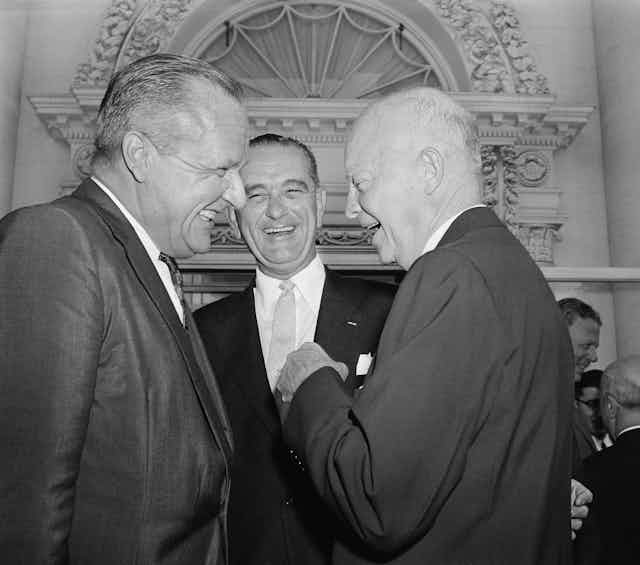Our nation has been ripped apart by political discord, ad hominem attacks and deep rifts between the dominant political parties.
But history provides a lesson about how the United States can return to bipartisanship and more civil political discourse.
The period I want to focus on covers the years from 1953 to 1961 and the two administrations of Republican President Dwight D. “Ike” Eisenhower, which I wrote about in my book “Eisenhower: Becoming the Leader of the Free World.” That study and my years of editing Eisenhower’s papers convinced me that our society can learn a great deal from his approach to the conflicts that always exist in American politics. Today’s angry division is not unique.
Forged unity despite differences
Throughout World War II, Eisenhower, then supreme commander of the Allied Expeditionary Forces, understood that he had to work every day to preserve the unity of the Allied forces. He was successful in this essentially political effort because he kept a firm grip on his priorities.
Following the war, he tried with only partial success to achieve similar unity between the military services. As the post-war North Atlantic Treaty Organization, or NATO, commander, he was a positive and vigorous advocate of unified action to prevent Soviet aggression.
Eisenhower thus came into office in 1953 with a well-established record of decisive action. He entered the presidency with a willingness to continue working with those who disagreed with him.

As president, Eisenhower consistently took unexpected positions for a Republican. He refused to cut taxes on those upper-income groups that had traditionally supported and heavily influenced his own party. Instead, he worked to cut spending and balance the budget, a goal he achieved three times during his two terms.
By holding down inflation and promoting steady growth, Eisenhower helped Americans on fixed incomes as well as those promoting new or expanding enterprises. He also supported additions to Social Security, a New Deal program that he considered a permanent and absolutely essential part of American public policy. That position was more in line with Democratic orthodoxy than Republican.
Where innovations were needed, Eisenhower worked with both Democratic and Republican leaders in the House of Representatives and the Senate to promote progress. Typical of his leadership was the creation of the federally sponsored national highway system.
The new program provided the kind of public infrastructure that Democrats had long supported. It also pumped money into the companies that built the roads and was supported by Republicans who saw it as a step forward in national defense. The new national road system would enable American forces to move quickly and efficiently to any part of the country under attack.

Some of these measures were easy to achieve, others were extremely controversial and difficult to promote. That was certainly the case with Eisenhower’s bill to advance the civil rights of African-American citizens.
The Civil Rights Act of 1957 expanded voting rights protections for blacks, formed a civil rights law enforcement division in the Justice Department and created the U.S. Civil Rights Commission.
Opposition to the proposed law was fierce – especially in the South, including by Southern Democrats.
Sen. Lyndon B. Johnson, a Democrat from Texas, was, however, willing to work with Eisenhower to overcome the congressional resistance to the new policy.
It was the country’s first civil rights law since Reconstruction. It was too weak a measure to change much. But it ended the pattern of federal acceptance of racial segregation, much of it supported by Southern opposition in Congress to civil rights.
Divisions then, divisions now
You may well be thinking that the 1950s were just completely different and have little to teach Americans today.
Don’t today’s identity politics make compromise and bipartisanship impossible? What about the Tea Party conservatives? What about the solid left wing of the Democratic Party? Don’t these factions find it had to talk to one another, let alone compromise to pass new laws?
You are right, of course, about the forces pulling Americans apart today. And, yes, Eisenhower’s America was different. But the truth is Americans were divided in Eisenhower’s time as well.
In the 1940s and 1950s there were deep fissures in the American population over issues such as sending U.S. soldiers to Europe in peacetime to defend our European allies.
Eisenhower – the former commander of NATO troops in Europe – vigorously supported America’s contributions to NATO. He did so even though many of his fellow Republicans backed Sen. Robert A. Taft of Ohio, who initially led the opposition to the new U.S. role in the world.
There were similar divisions about domestic policy. There were millions of Americans – including my father – who were so bitter about the New Deal support for unions that they could not even think about compromising with the Democrats promoting President Harry Truman’s liberal Fair Deal, an initiative that expanded domestic social programs.
The right wing of the Republican Party gave Eisenhower fits. Every step he took toward unity at home and among America’s friends abroad had to be pushed through over the resistance of the Republican right. Foreign aid, for instance, aroused bitter fights.
And the Democrats had similar problems with the split between their Southern supporters and their big-city Northern party members over any issue that seemed to promote change in race relations. Identity politics are not new to America in the 21st century.
What about the Cold War? Didn’t Eisenhower and his colleagues have the advantage of working against a single opponent, the communist forces led by the USSR?
In reality, communism was never a completely unified force, and like today, the United States had to deal with a wide variety of challenges to its national security.
In East Europe, in the Middle East, in Korea and in the South China Sea, American interests are no more secure now than they were in the 1950s. Americans aware of these challenges have just as strong an incentive to work together as they did during the Eisenhower administrations.
But can Americans work together? Can a nation of 323 million people turn back toward bipartisanship?
That, I believe, calls for the kind of outstanding leadership this nation and its allies received in the 1950s. Eisenhower called his form of politics the “Middle Way” between the extremes of the left and right.
He accomplished much by being able to talk to, and work with, both sides on every issue. For a nation now mired in partisan conflict, his model of getting things done by taking the “Middle Way” could provide a welcome alternative.
We need our leaders to help turn us in that direction. Then, of course, all of us, the voters, will have a chance to decide whether indeed we actually want bipartisanship and the compromises it entails. I hope I will have that choice to make in my lifetime.


